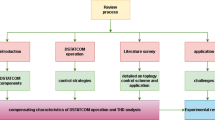Abstract
This paper proposes a new approach for stator current analysis, based on empirical demodulation (ED) and discrete wavelet transform, for detection and diagnosis of broken rotor bars in three-phase induction motors under low and high slip conditions. Unlike the traditional motor current signature analysis, the method proposed is not dependent on the load and a higher spectral resolution obtained from a larger acquisition time when the motor operates at low slip condition. In this work, firstly, the motor steady-state current signals are filtered using a band-pass filter. Then, the modulation components are extracted using a demodulating technique recently proposed (ED). Finally, the modulator signals are decomposed via wavelet transform and are analyzed by using a derived orbit shape. Computer simulations and experimental tests demonstrate the superior performance of the proposed method. It is simple and easy to implement.










Similar content being viewed by others
References
Nandi S, Toliyat HA, Li X (2005) Condition monitoring and fault diagnosis of electrical motors—a review. IEEE Trans Energy Convers 20(04):719–729
Singh A, Grant BB, DeFour R, Sharma C, Bahadoorsingh S (2016) A review of induction motor fault modeling. Electr Power Syst Res 133:191–197
Zhang P, Du Y, Habetler TG, Lu B (2011) A survey of condition monitoring and protection methods for medium-voltage induction motors. IEEE Tran Ind Appl 47(1):34–36
Bonnett AH, Albers T (2001) Squirrel-cage rotor options for ac induction motors. IEEE Trans Ind Appl 37(4):1197–1209
Benbouzid MEH (2000) A Review of Induction Motors Signature Analysis as a Medium for Faults Detection. IEEE Trans Ind Electron 47(5):984–993
Henao H, Razik H, Capolino GA (2005) Analytical approach of the stator current frequency harmonics computation for detection of induction machine rotor faults. IEEE Trans Ind Appl 41(3):801–807
Messaoudi M, Sbita L (2010) Multiple faults diagnosis in induction motor using the MCSA method. Int J Signal Image Process 1(3):190–195
Gaeid KS, Ping HW, Khalid M, Salih AL (2011) Fault diagnosis of induction motor using MCSA and FFT. Electr Electron Eng 1(2):85–92
Saidi L, Fnaiech F, Henao H, Capolino GA, Cirrincione G (2013) Diagnosis of broken-bars fault in induction machines using higher order spectral analysis. ISA Trans 52:140–148
Yang C, Kang TJ, Hyun D, Lee SB, Antonino-Daviu JA, Pons-Llinares J (2014) Reliable detection of induction motor rotor faults under the rotor axial air duct influence. IEEE Trans Ind Appl 50(4):2493–2502
Kaikaa MY, Hadjami M (2014) Effects of the simultaneous presence of static eccentricity and broken rotor bars on the stator current of induction machine. IEEE Trans Ind Electron 61(5):2452–2463
Bessam B, Menacer A, Boumehraz M, Cherif H (2016) Detection of broken rotor bar faults in induction motor at low load using neural network. ISA Trans 64:241–246
Sapena-Bãno A, Pineda-Sanchez M, Puch-Panadero R, Martinez-Roman J, Kanovic Z (2015) Low-cost diagnosis of rotor asymmetries in induction machines working at a very low slip using the reduced envelope of the stator current. IEEE Trans Energy Convers 30(4):1409–1419
Yahia K, Cardoso AJM, Ghoggal A, Zouzou SE (2014) Induction motors airgap-eccentricity detection through the discrete wavelet transform of the apparent power signal under non-stationary operating conditions. ISA Trans 5(3):603–611
Peng ZK, Chu FL (2004) Application of the wavelet transform in machine condition monitoring and fault diagnostics: a review with bibliography. Mech Syst Signal Process 18:199–221
Kia SH, Henao H, Capolino GA (2007) A high-resolution frequency estimation method for three-phase induction machine fault detection. IEEE Trans Ind Electron 54(4):2305–2314
Bellini A, Franceschini F, Tassoni C (2006) Monitoring of induction machines by maximum covariance method for frequency tracking. IEEE Trans Instrum Meas 42(1):69–78
Aiello M, Cataliott A, Nuccio S (2005) An induction motor speed measurement method based on current harmonic analysis with the chirp-Z transform. IEEE Trans Instrum Meas 54(5):1811–1819
Naha A, Samanta AK, Routray A, Deb AK (2016) A method for detecting half-broken rotor bar in lightly loaded induction motors using current. IEEE Trans Instrum Meas 65(7):1614–1625
Dias CG, Chabu IE (2014) Spectral analysis using a hall effect sensor for diagnosis broken bars in large induction motors. IEEE Trans Instrum Meas 63(12):2890–2902
Yang T, Pen H, Wang Z, Chang CS (2016) Feature knowledge based fault detection of induction motors through the analysis of stator current data. IEEE Trans Instrum Meas 65(3):549–558
Sadeghian A, Ye Z, Wu B (2009) On line detection of broken rotor bars in induction motors by wavelet packet decomposition and artificial neural networks. IEEE Trans Instrum Meas 58(7):2253–2263
Jedlinski L, Jonak J (2015) Early fault detection in gearboxes based on support vector machines and multilayer perceptron with a continuous wavelet transform. Appl Soft Comput 30:636–641
Doua D, Zhou S (2016) Comparison of four direct classification methods for intelligent fault diagnosis of rotating machinery. Appl Soft Comput 46:459–468
Lei Y, Lin J, He Z, Zuo MJ (2013) A review on empirical mode decomposition in fault diagnosis of rotating machinery. Mech Syst Signal Process 35:108–126
Georgoulas G, Tsoumas IP, Antonino-Daviu JA, Climente-Alarcón V, Stylios CD, Mitronikas ED, Safacas AN (2014) Automatic pattern identification based on the complex empirical mode decomposition of the startup current for the diagnosis of rotor asymmetries in asynchronous machines. IEEE Trans Ind Electron 61(9):4937–4946
Xu B, Sun L, Xu L, Xu G (2013) Improvement of on the hilbert method via ESPRIT for detecting rotor fault in induction motors at slow slip. IEEE Trans Energy Convers 28(1):225–233
Sapena-Banõ A, Pineda-Sanchez M, Puche-Panadero R, Perez-Cruz J, Roger-Folch J, Riera-Guasp M, Martinez-Roman J (2015) Harmonic order tracking analysis: a novel method for fault diagnosis in induction machines. IEEE Trans Energy Convers 30(3):833–841
Batista FB, Lamim Filho PCM, Pederiva R, Silva VAD (2016) An empirical demodulation for electrical fault detection in induction motors. IEEE Trans Instrum Meas 65(3):559–569
Benbouzid MEH, Kliman GB (2003) What stator current processing-based technique to use for induction motor rotor faults diagnosis? IEEE Trans Energy Convers 18(2):238–244
Gritli Y, Zarri L, Rossi C, Filippetti F, Capolino GA, Casadei D (2013) Advanced diagnosis of electrical faults in wound-rotor induction machines. IEEE Trans Ind Eletron 60(9):4012–4024
Cunha CCM, Lyra ROC, Filho BJC (2005) Simulation and analysis of induction machine with rotor asymmetries. IEEE Trans Ind Appl 41(1):18–24
Acknowledgements
The authors would like to express their warm appreciation to the Federal University of São João del Rei (UFSJ).
Author information
Authors and Affiliations
Corresponding author
Additional information
Publisher's Note
Springer Nature remains neutral with regard to jurisdictional claims in published maps and institutional affiliations.
Appendix
Rights and permissions
About this article
Cite this article
Lamim Filho, P.C.M., Baccarini, L.M.R., Batista, F.B. et al. Broken rotor bar detection using empirical demodulation and wavelet transform: suitable for industrial application. Electr Eng 100, 2253–2260 (2018). https://doi.org/10.1007/s00202-018-0700-1
Received:
Accepted:
Published:
Issue Date:
DOI: https://doi.org/10.1007/s00202-018-0700-1




